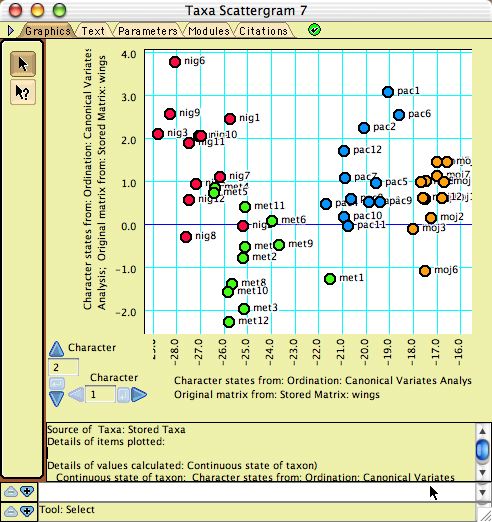Analyzing Continuous Characters
Continuous characters (e.g., with values 1.21, 5.68, and so on) can be edited, manipulated, simulated and analyzed in various ways in Mesquite. Below is a brief outline of these features, some of which come from the standard packages of Mesquite, others of which come from the built-in Rhetenor package (by Dyreson and Maddison) and the separately-available PDAP package (by Midford, Garland & Maddison). Many of these calculations are more thoroughly illustrated in the example files under Mesquite_Folder/examples/Basic_Examples/continuous/, and under Mesquite_Folder/examples/Multivariate_Continuous/Contents
- Editing continuous data
- Reconstructing ancestral states
- Plotting trees
- Simulating character evolution
- Ordinations
- Tree reconstruction
- Felsenstein's independent contrasts
- Geometric morphometrics
Reconstructing ancestral states
Ancestral states of continuous characters can be reconstructed as described in the page on reconstructing ancestral states.Plotting trees
Trees can be mapped or plotted into a character space as described in the page on processes of character evolution.Simulating character evolution
Evolution of continuous characters can be simulated by selecting Simulated Characters or Simulated Matrices, and choosing Evolve Continuous Characters. You will get to choose a model, which will be used to simulate evolution on the tree. There is one default model, a Brownian motion model with rate parameter of 1.0. You can create alternative models (e.g. other Brownian motion models) by selecting New Character Model in the Characters menu.Ordinations
Where matrices of continuous characters are used, for instance in plotting trees or in Taxa Scattergrams, it is possible to instead use characters representing the modified axes obtained by ordinations such as Principal Components Analysis using modules in the built-in Rhetenor package. For instance, the following Taxa Scattergram shows the results of a Canonical Variates Analysis:
To use ordinations, simply select Characters from Ordinations or Matrices from Ordinations wherever you might otherwise select Stored Characters or Stored Matrices. There are several options for ordinations:
- Principal Components Analysis
- Canonical Variates analysis — This requires a Taxa Partition to exist to indicate groups of taxa.
- Among-group PCA
- Within-group PCA
- Evolutionary PCA (similar to PCA but tree-based)
Tree reconstruction
The tree search facility (available under Trees&Taxa>Make New Trees Block from>Tree Search) allows one to search for trees minimizing treelength as calculated by linear or squared change parsimony for continuous characters. It should be noted, however, that the current Tree Search facilities in Mesquite do not adjust branch lengths. The squared change parsimony algorithms by default weight by branch length. Thus, the search is done effectively under the constraint that all trees have branch lengths of 1.0.Felsenstein's independent contrasts
Analyses of character correlations can be done by the separately-available PDAP package. This is described briefly here.Geometric morphometrics
Landmark data can be entered in Mesquite as a continuous matrix with multiple items. Each character is a landmark, and each item is a dimension of the landmarks' coordinates. Thus, for two dimensional landmarks, the matrix could have the items "x" and "y".Mesquite cannot yet perform Procrustes analyses to bring landmarks into a common scaling and alignment across taxa, but given that the data is already so prepared, the Landmark Drawings module of the Rhetenor package can reconstruct ancestral forms as shown below: